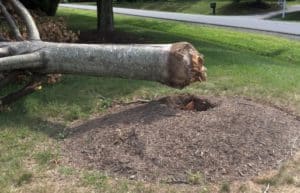Proper Mulching Tips
Proper Mulching Tips: Stop the Madness – Say NO to Mulch Volcanoes!
There’s no surer way to ensure the death of a tree than to over mulch it. You see it everyday. Homeowners invest thousands of dollars and sweat equity planting trees and shrubs to beautify their landscapes and often, unknowingly, apply excess mulch around the root flare. Aesthetically it may be attractive, but it sets up trees and shrubs for a myriad of health problems that will usually lead to their eventual decline. Below is a well-written article on the effects of over-mulching by Glenda Weber (reprinted with permission).
Mulch Volcanoes Are Proven Tree Killers
 By Glenda Weber
By Glenda Weber
Baltimore City Recreation and Parks
Most people know drinking and driving don’t mix but did you know trees and volcanoes don’t mix? Volcanoes? In Baltimore? Yep, I see volcanoes all over the city and beyond.
On my daily commute, I have watched trees be planted, carefully surrounded by a volcano of mulch and that poor tree spends the next three to five years dying. By volcanoes, I mean mulch piled in a dome around the trunk of the tree. Frequently the tree is young or newly planted and the homeowner wishes to give the tree some tender loving care. Except this is a death wish, not TLC.
Piling any type of mulch around the trunk causes numerous problems for the tree. The bark of a tree is its outermost protective layer. The bark needs to be exposed to the air in order to function properly. Bark forms a barrier between the living, growing, inside part of the tree and the “bad guys” who wish to destroy it. Moisture from the mulch softens the bark and aids their dastardly deeds. The “bad guy” list includes:
- Bacteria, viruses and fungi that consider the bark part of the mulch pile. Their job is to decompose or break down mulch into good-for-the-earth compost. Bark being used by the tree should not be on their menu;
- Varmints such as mice and meadow voles will chew through the bark to get to the tasty, living, inner bark. This activity cuts off the tree’s flow of nutrients and starves it to death. Mulch volcanoes provide a perfect space for rodents to tunnel through to reach the tree trunk. The tunnels protect them from predators such as foxes, cats, hawks and owls;
- Insects and other creepy-crawlies also tunnel through mulch volcanoes to reach now-softened, partly decomposing, chewed-on bark. It’s like an open-door invitation to come in, chew through the wood and introduce any diseases they carry.
Mulch “rings” around trees protect the tree from lawn mower and trimmer string attacks, help retain soil moisture, keeps the ground cooler in summer and helps prevent soil heaving in winter. As the mulch decomposes it provides needed nutrients for tree roots. And it looks nice. So what’s a homeowner or landscape professional to do?

An example of the damage done over time by overmulching.
A proper mulch ring meets these criteria:
Size—A ring anywhere from a 2- or 3-foot radius around the trunk to the tree’s drip line. A mulch ring should be a protection zone for the tree’s roots. Give those roots as large a protection zone as possible.
Depth—About 2-3 inches are plenty. Thicker layers of mulch inhibit oxygen exchange between tree roots and the air. Healthy roots need to breathe. It is okay to “cup” the mulch at the outer edge to help retain water but this is only used for 2-3 years on newly planted trees. Do not have any mulch touching the tree’s bark.
Material—My first choice is well-aged wood chips. Shredded bark and compost also work. I do not recommend dyed mulches, decorative mulches or the new rubber mulches. The concern with these is reduced air supply and the potential release of chemicals toxic to plants. Fresh wood chips or sawdust should also not be used. They rob the soil of nitrogen as they break down.
Trees larger than about a 10-inch diameter usually do not need mulching, though it may be done to include them in a landscape planting bed. Water the trees when the top 1-3 inches of soil is very dry to the touch. Add 2-2 1/2 inches of water throughout the root zone.
Well-intentioned people who don’t know what is really happening to their trees often build the mulch volcanoes. Now you know better—spread the word. Please.
Glenda Weber is the naturalist for Baltimore City Recreation and Parks. She leads the nature programs conducted at Cylburn Arboretum, and Howard Peters Rawlings Conservatory and Botanical Gardens. She can reached at glenda.weber@baltimorecity.gov.
